If you wish to use the photographs published in the exhibitions, please write a free-form request to the Director of the KTU Library and obtain her permission.
KTU Library virtual exhibition
If you wish to use the photographs published in the exhibitions, please write a free-form request to the Director of the KTU Library and obtain her permission.
Ogiński noble family is descended from the Ruthenian lands of Smolensk, settled in the Grand Duchy of Lithuania (GDL) at the end of the 15th and the beginning of the 16th century. According to Dr. Jolanta Skurdauskienė, even though the Ogiński family had estates in Samogitia and in the territory of present-day central Lithuania as early as the 16th century, by the end of the 18th century the largest complexes of Oginskis’ estates had been formed in the eastern lands of the GDL, in the voivodeships of Vilnius, Vitebsk and Minsk. At the beginning of the 19th century, the representatives of the dukedom branch of the Ogiński family moved their residence to Rietavas.
This noble family has left a strong imprint on Lithuanian history. From the 16th century until the end of the country’s existence (1795), among the Ogińskis there was one chancellor of the GDL, a grand marshal and a treasurer, three hetmans, nine voivodes, ten castellans and other high-ranking officials.
One of the most famous representatives of this family is Duke Michał Kleofas Ogiński (1765-1833), a diplomat, a political figure of the Polish–Lithuanian Commonwealth, one of the leaders of the Kościuszko Uprising, who later became a senator and a secret advisor to Tsar Alexander, an honorary member of Vilnius University, a composer, he was awarded the Order of St. Stanislovas and the Order of the White Eagle for the merits for the homeland. With his first wife, Izabela Lasocka, he had two sons, Tadeusz and Franciszek Ksawery, and with his second wife, the Italian-born Maria de Neri, he had three daughters, Amelia, Emma and Ida, and a son, Ireneusz Kleofas.
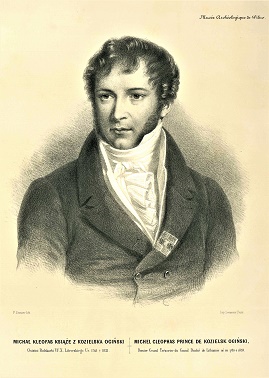
After the death of his father, Ireneusz Kleofas Ogiński (1808-1863) inherited the Rietavas manor and moved the books from the Zalesė library to it. Ireneusz Kleofas Ogiński was a Marshal of the Raseiniai nobility, superintendent of schools in Kaunas Governorate. He took care of the town of Rietavas, there he established a hospital, a pharmacy, an orphanage, a shelter for the elderly, several savings and loan banks, a post office, and the first two-grade agronomy school in Lithuania. The Duke and his wife Olga Kalinovska-Ogiński (1820-1899) raised two sons: Bogdan Franciszek Józef Michał and Michał Mikołaj Seweryn Marek.
After the death of his father Ireneusz Kleofas, the valuable books in his library were passed on to his sons, Bogdan and Michał.
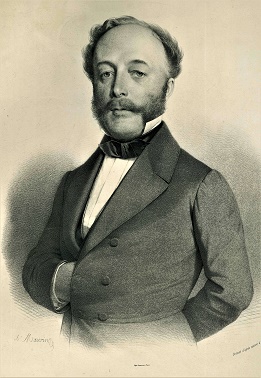
The exhibition presents the most valuable books of the Ogińskis’ collection, stored in the KTU Library’s Stock of Rare Books. They are distinguished by the notes in the Library’s inventory books and by the book’s ownership marks, such as stamps and inscriptions. According to Jadvyga Misiūnienė, documents preserved in the Lithuanian State Historical Archives testify to the existence of libraries in the Ogińskis’ manors. This is confirmed by the 1745 list of library books of the Vitebsk Voivode compiled by Michał Kleofas’ great-grandfather, Marcjan Michał Ogiński, and by his father’s Andrzej Ignacy Ogiński’s catalogue of the library of the Trakai Voivode, which was compiled in 1786 at the Guzov manor by Jean Rolay, the music teacher of Michał Ogiński.
Michał Ogiński had a rich family archive, a library, and a picture gallery at Zalesė Manor near Smarhoń (now in the Ashmyany district of Belarus), which he inherited from his uncle Franciszek Ksawery Ogiński.
According to Misiūnienė, unlike the libraries of the Zalesė and Rietavas manors, the library of Plungė had a specially designed ownership mark – a seal depicting the coat of arms of Michał Ogiński and his wife Maria Teresa Kasper Skórzewska-Ogiński, with the inscription at the bottom “Biblioteka Płungiańska”. There are 41 prints with this stamp in the Ogiński collection. Several of the books are convolutions (i.e. several prints bound in one volume), making a total of 76 titles.
The collection includes several books from the library of Rietavas Manor. They are distinguished by entries mentioning Duke Bogdan Ogiński and Duke Ireneusz’s wife Olga Ogiński (Kalinovska), or marked “Exlibris Ogiński”.
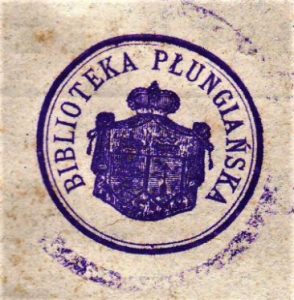
Ogińskis’ book collection received special attention when the Group of the Stock of Rare Books of the KTU Library started to collaborate with the Samogitian Art Museum (hereafter referred to as SAM), which is located in Plungė, in the manor of the Dukes Ogińskis. In 2015, the most valuable prints of Ogiński’s preserved in the KTU Library were displayed in the exhibition “The Revived Ogiński Library” organised by SAM. In 2016, the library, together with SAM, participated in the project “M. M. Ogiński Library Books from the 15th to the 19th Century”, which included the creation of posters for the titles and the most informative pages of the publications. The aim of this exhibition is to introduce the achievements and interests of the Dukes Ogińskis, and to present the books collected and handed down from generation to generation by their family.
The exhibition was organised in collaboration with the Samogitian Art Museum. Sincere thanks to Dalia Šimkute, Head of the Scientific Library of the Samogitian Art Museum, for her comments, additions and advice. Some book titles have provided translations. These texts have been translated by Dr. Rita Urbaitytė, a member of the Department of Old and Rare Books of the Kaunas County Public Library.
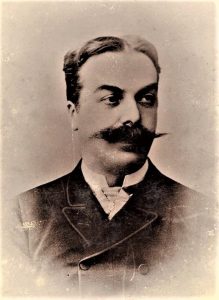
From 1881 to 1885 Michał Mikołaj Ogiński was the head of the Telšiai City Duma, the head of the Telšiai county nobility, the chairman of the Voluntary Firefighters’ Society, the head of the firefighter team, and the chairman of the Plungė Savings Society from 1899.
In 1875 he established an auxiliary post-telegraph station in Plungė. For this, the Duke provided a house and heating, hired workers himself, and made sure that a railway was built through Plungė.
Around 1900, he secured permission from the Tsar for the construction of a new church in Plungė, brought the project from Italy, and allocated funds for the construction. After Duke’s death, his wife financed the construction of the church. These foundations of the Church of St. John the Baptist were consecrated in 1905, and the construction was completed in 1933.
He studied at the Šiauliai “Aušra” (Eng. Dawn) Boys’ Gymnasium, he was fond of music, and could play several musical instruments. Around 1873, he founded a music school in the palace, which operated until 1902, and maintained an orchestra of the manor. Mikalojus Konstantinas Čiurlionis studied at the Plungė Music School from1889 to 1892. Ogiński provided support for Čiurlionis when he was studying at the conservatories in Warsaw and Leipzig. After the death of the Duke, the music school ceased its activities, and the Plungė Manor Orchestra was also disbanded.
In 1883, Duke Michał Ogiński established a private two-grade school in one of the former houses on the grounds of his manor. Around 100 children started attending it in the autumn. The Duke had invited 3 teachers to teach them. This little school lasted only 10 days, as it was banned by the Tsarist authorities.
The Duke supported the Lithuanian national movement, financially contributed to the printing and transportation of banned books, helped peasant children to pursue their education, and spoke Samogitian to the rural population. In 1875, he submitted a manuscript to the Petersburg Censorship Committee with a request for permission to print Laurynas Ivinskis’ booklet “Pamokimaj kaip rejkie saugote kiek wieną giwa sutverimu….” (Teachings on how to protect every alive being). Before the ban on the Lithuanian press was lifted, he submitted applications for three more small books.
The Ogińskis cared not only for children and orphans, but also provided help to old people’s homes, hospices for the cholera-stricken, a 30-bed hospital, and individual charity for people living in poverty. Maria Teresa Kasper Ogiński (Skórzewska), the wife of Michał Mikołaj Ogiński, a Polish-born countess and duchess, took care of the orphanage for infants and children, educated several children at her own expense, and maintained an old people’s home and hospital. According to the pastor of Plungė, Vincentas Jarulaitis, the Duchess, “who came from a distant foreign land, loved Samogitia as if it was truly her own land, and she showed her love not with her words, but with the most beautiful deeds” (PKP, p. 713.).
Michał Mikołaj Ogiński was also an honorary member of the Board of the Rietavas Branch of the Raseiniai County Society for the Care of Animals, vice-chairman and honorary member of the Rietavas Society for the Promotion of the Breeding of Horses of the Žemaitukas Breed. The first agricultural exhibition in Plungė in 1899 featured about two hundred horses, flower, fruit, vegetable and cereal pavilions.
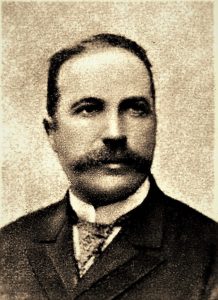
In 1882, the Duke initiated the construction of the first telephone line in Lithuania in Rietavas, which connected the manors of Rietavas, Plungė and Kretinga.
In 1892, a power plant started working; on the same year, the first electric light bulb in Lithuania was lit in the church of Rietavas on Easter morning (the first electric power plant in the world was opened in 1882 in New York). It supplied electricity not only to the manor, but also to the town.
The neo-romanesque, planned after the Latin cross, basilican, two-tower church of Rietavas Church of Archangel Michael was completed in 1874.
In 1887, an emergency department of Raseiniai Hospital was opened in Rietavas.
In 1895, a unique water tower with a wind turbine was built and equipped for operating, 7 mills, 6 sawmills, a furniture factory, a leather factory, an iron foundry, an agricultural machinery and tool factory, a soap factory, a butter and cheese factory were built as well.
In 1872, the first professional six-year music school was established in Lithuania, where children were taught music theory, violin and organ playing. In 1883, an orchestra was founded, in which most of the pupils of the local music school played. The orchestra performed in Lithuania, Latvia, and even went to play further abroad. The school was funded and maintained by Duke Bogdan Ogiński. After the death of their patron, some members of the orchestra went to live in America, where they formed the famous “Lietuva Band Chicago” orchestra before the First World War.
The Duke supported the Lithuanian national movement. He supported the people of Kražiai who were protecting their church in 1893. When he learned about the events in Kražiai, he made sure that the news about the crackdown were spread all over the world, and that the Tsar’s policy against the Lithuanian nation was condemned.
Bogdan Ogiński was concerned with the international recognition and preservation of the Žemaitukas horse breed. In 1881, on the initiative of the Duke, the Society for the Encouragement of the Breeding of Žemaitukas Horses was established in Raseiniai, and in 1883, in Plungė. In 1873, the Rietavas branch of the Russian Society for the Protection of Animals was established (it was active until 1902), and Duke himself took an active part in its activities. During the same year, a veterinary clinic was established in Rietavas, with premises provided by Dukes Ogińskis.
In 1875, the first agricultural exhibition in Lithuania was held in Rietavas.
Michał Mikołaj Ogiński refused to move to the manor in Zalesė, which he inherited from his grandfather Michał Kleofas Ogiński.
In 1879, in cooperation with the German architect Karl Lorenz, the Duke completed and consecrated a magnificent Neo-Renaissance palace in Plungė, which was organically integrated into the mixed-style park formed on the site of a natural forest, which was enriched by the two chains of ponds. The manor included two outside servant buildings, a Neo-Gothic stable, a laundry, an orangery, and a park with a main gate.
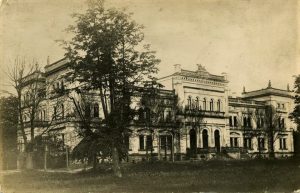
The palace contained “around 100 portraits of the Ogiński family, paintings by famous artists, marble busts, a collection of Samogitian archaeological finds, a collection of precious porcelain, a collection of numismatics, an archive, and a rich library with a separate reading room” (ĮLD, p. 272). “The Ogiński Library with a separate reading room was located on the second floor of the palace. The bookcases reached the ceiling. According to Paulius Galaunė, who visited the library after the First World War, the doors of the bookcases were glass-paned, and they were lockable.” (ALD, p. 74).
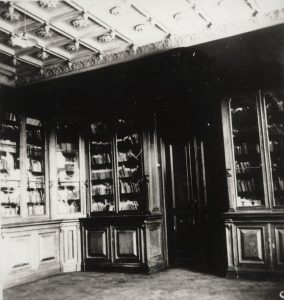
According to Šimkutė, “a surviving nineteenth-century black-and-white photograph of a fragment of the library shows that the ceiling of the room was decorated with plaster mouldings, wooden coat of arms of the Skórzewski and the Ogiński families was mounted above the massive double wooden doors, and books were stored in dark wood bookcase (with glass doors that opened)” (ŠAOB).
After the outbreak of the First World War, the widow Maria Ogiński left for Poznan (Poland) and never returned to Plungė.
During the interwar period, the manor house housed the Saulės (Sun’s) Gymnasium, later it was used for the School of Agriculture, and from 1934 the Artillery Regiment of the Lithuanian Armed Forces was located there. All that remains of this period are small fragments about the fate of the library: The cabinets, used at the end of the 19th century, stood undisturbed in the library, until the library was almost completely destroyed (ĮLD, p. 273).
Michał Ogiński brought his grandfather’s books from the inherited Zalesė Manor to the Plungė Manor Library. This library contained old and rare books, Elsevier small format books, philosophical and artistic publications (ALD, p. 74). He also took part of the library of his parents’ manor in Rietavas. It is believed that not only the Ogiński family, but also guests, servants, orchestra musicians, and teachers read the books in the library of Plungė Manor.
The library of the last owner of the Plungė manor was distinguished by its diversity of languages and genres. According to Šimkutė, it contained a manual on insects published in 1802 by the French inventor, entomologist Charles Athanase Walckenaer, works of one of the most eminent representatives of the Age of Enlightenment, Voltaire-François-Marie Arouier, and French philosopher and mathematician, Blaise Pascal, the works of the French historian Augustin Thierry, works of the Italian historian Cesare Cantu, the historical study “Recherches historiques sur l’origine des Sarmates” written by the first bishop of Belarus, Stanislaw Bohusz-Siestrzeńcewicz… ” (1812 m. ), the works of playwright Thomas Corneille, poet and translator Jacques Delille, poet Jean Reboul, etc., there were also a number of musical works (ŠAOB). According to the publication “Museum of Samogitian Art”, “the family archive maintained by Dr. Paškovskis was very valuable. Ogiński Plungė Manor Library was famous for its exceptionally old scroll manuscripts” (MŽDM, p. 11, 12).
The main building of the manor, the palace itself, has not survived. Their location is marked by a colonnade and a lamppost. “The estate’s buildings from the mid-19th century to the second half of the 20th century have been preserved: servant house, a stable, music school, musicians’ dormitory, brewery, laundry, water tower, chapel, mausoleum, guards’ house, fragments of a fence, a white gate and a red gate. A green park with ponds, founded in 1850-1855.” (SLD, p. 342). In 1909, the main manor palace burnt down, destroying works of art and a valuable library.
According to Misiūnienė, in January 1919 the Lithuanian Central Bookstore (Lietuvos centrinis knygynas) was established in Vilnius in accordance with a decision of the People’s Commissariat of Education, and Eduardas Volteris was appointed its manager. In April, after the Polish legions occupied Vilnius, the library was moved to Kaunas and resumed its activities as the State Central Bookstore. By order of the Provisional Government of Lithuania, the Library was granted the right to expropriate the libraries of the former tsarist institutions in Lithuania, and to register and maintain the private collections of books left without owners. Even in the first years of its operation, the library staff, ordered by the Ministry of Education, went on expeditions to collect books that had been left in the manors without their owners. They were supervised by Konstantinas Jablonskis, secretary of the State Archaeological Commission, lawyer and historian.
Books from Rietavas and Plungė went to two state repositories: the State Central Bookstore in Kaunas and the Šiauliai Central Bookstore.
The Library’s inventory books help to determine how the books of the Ogiński collection came to the KTU Library. According to them, most of the prints in this collection were obtained from the State Central Bookstore between 1925 and 1937, and only four prints were obtained from other sources. The publication “Atlas statystyczny Polski i krajów okolicznych…” (1827), published in Polish and French in 1937, was obtained from Kaunas City Museum. In 1937 and 1942, the Library received two donations: “Atlas de lagéographie ancienne, du moyen-age, et moderne,…”, published in Paris in 1807 by the cartographer Charles François Delamarche, and “Carte de la Pologne divisée par provinces …”, compiled in Paris in 1772 by the cartographer Giovanni Antonio Rizzi Zannoni.
In the book “O progresji transcendentalnej oraz o skali i siłachumy słuludzkiego…” (1897) by Antanas Baranauskas, not only the stamp of the Bibliotheca Płungianska is found, but also the stamp of the Higher Courses (which was active in the period of 1920-1922). The library of the University’s predecessor was built up from a variety of sources: publications were purchased, brought from home by lecturers, and donated, depending on the study programmes.
The Library’s Inventory Books show the Ogińskis’ music sheets stored in the KTU Library, which were handed over to the Petrauskai Lithuanian Music Museum in 1971-1980.
The most valuable exhibits of the Oginski collection are the incunabula (books published before 1501) and commemorative literature from the 17th and 18th centuries, in which the most important events in the life of the Ogiński family are commemorated in Latin and Polish.
The Ogiński Library contains two incunabula. They are the “Libri dialogorum sancti Gregorii pape” (Dialogues…) ( Fig. 6) and Homiliae super Ezechielem (Homilies on the prophet Ezekiel), published in Latin by Pope Gregory I in 1496. These books are described in Noah Feigelman’s catalogue “Lithuanian Incunabula” and in the catalogue “Books from the 15th to 16th centuries in Kaunas Libraries” prepared by the Kaunas County Public Library (KCPL). The presented books were bound in the first half of the 20th century, the edges of the block are speckled with red paint, and there are many marginalia: textual and manuscript annotations, underlinings.
The collection includes one book each from the 16th and 17th century. The 16th century is represented by the first set of Polish laws published in Cracow in 1506 by Jan Łaski (1456-1531), a Polish statesman and churchman, in the form of the first set of laws of Poland, the “Privilegium constitutionum et indultuum of the Commune of the Inner City of the Polanyi Region” (Fig. 7), which is also known as the “Łaski’s Statute…”. This book is also described in the aforementioned catalogue published by KCPL. It is bound in cardboard and brown leather, the edges of the remaining binding straps are visible, and the edges of the block are speckled with red paint. The book contains some marginalia: certification marks.
In the second half of the 17th century, the printing house of the Vilnius Academy published the book “Iter gloriæ a porta gentilitia usq[ue] ad portas mortis per Martis campos…” (Fig. 8). The book has a dedication: “Praæfatio ad illustrissimum dominum D. Martianum de Kozielsko Oginski, palatinum Trocensem […] capitaneum, dedicated to the Voivode of Trakai, Marcjan Aleksander Ogiński. There is an entry in the book that indicates that it also belonged to the Jesuit College of Pinsk.
“The journey of glory patiently walked by the highly respected and virtuous gentleman, Jan of Kozielsk Ogiński, Marshal of Bratslav, from the gates of his family, through the fields of Mars, the squares of state, the venerable halls of heroic virtue and merit, and to the gates of death, has been presented to the everlasting memory of posterity with an obedient pen, and presented with the solemn ceremonial of the funeral of the compassionate academy of the Society of Jesus in Vilnius in 1680”.
The collection includes more books published in the 18th century. One of them is 5th and 6th volumes of the French edition of the 1732 map collection “Atlas historique, ou nouvelle introduction à l’histoire, & à la chronologie, & à la géographie ancienne & moderne”, (A historical atlas, or a new introduction to ancient and modern history, chronology and geography, presented in new maps…) (Fig. 9) by the cartographer, publisher and engraver Henri Abraham Chatelain (1684-1743). The publication is packed with informative and impressively detailed illustrations. The cover of the presented 5th volume is made out of leather with stamped gold-coloured ornaments, the edges of the book block are gilded. Sadly, there are defects, as both sides of the leather cover are badly damaged.
A special place is also occupied by the publication “Carte de la Pologne divisée par provinces et palatinats et subdivisée par districts…” (Map of Poland divided into provinces and palatines…), (Fig. 10) published in Paris in 1772 by Giovanni Antonio Rizzi Zannoni (1736-1814), a Venetian republican cartographer and author of many maps and atlases. The book contains a dedication to Duke Józef Aleksander Jabłonowski, a major magnate and statesman of the Polish-Lithuanian Commonwealth, Governor of Navahrudak , historian, bibliographer, heraldist, patron, etc.
The “Chronicle” (Fig. 11) of historiographer, poet and translator Marcin Bielski (1495-1575), who wrote about the history of Lithuania, and influenced the Polish historian Maciej Stryjkowski, also found a place in the Ogiński Collection. Although the “Chronicle” was published in 1551 and 1554, the third edition is the most important for Lithuania, providing information about the Grand Duchy of Lithuania. The displayed “Chronicle” is the first volume of a four-volume history collection published in Warsaw. The book shows two dedications in form of printed marginalia.
The collection of maps by the German geographer, cartographer, engraver and publisher Johann Baptist Homann (1664-1724), his pupil and, later, one of the most famous German map publishers of the 18th century, the engraver Matthäus Seutter (1678-1757), as well as by Seutter’s son-in-law, the German engraver and publisher, Tobias Conrad Lotter (1717-1777), takes a significant place. The publication includes a dedication to Duke Michał Ogiński entitled “Entry: Marszałkowi Mojemu Jasnie Oswicnemu Księciu Oginskiemu Michalowi do Zbiorow Starożytnoṡci s sklada. Boleslaw Sakich. 1877 Roka Septembra 29“.
The Ogińskis’ collection is distinguished by an oration by the Jesuit Felicjan Jozef Nowodworski, printed in 1753 in the printing house of the Vilnius Academy, extolling the virtue, glory and honour of the Voivode of Vitebsk, Marcjan Michał Ogiński.
The 18th-century collection is supplemented by two books published by the Vilnius Academy Printing House: „Facies Martis et Minervae in capite Oginscianae Prosapiae Vlodimiro principe…“, 1726 m. (Fig. 14) and „Via flaminia ab Oginscianæ domûs porta ad palatini honoris fastigium…“, 1730 m. (Fig. 15).
„The handsome face of Mars and Minerva in the head of Duke Vladimir’s relatives, the Ogińskis, crowned with military and written laurels, and now watched over from outside the palace gates by the brightest and noblest gentleman, Mr. Kazimierz Ogiński, the Voivode of Trakai and High Marshal of the Supreme Court of Palemon, The brightest, most highly esteemed, honourable and most noble youth of the Vilnius Academy and University of the Society of Jesus, enlightened by theatrical fires with gymnastic acts since the birth of the Incarnate Wisdom on the 1st of August 1726.“ (Fig. 14).
„Flaminius’ path from the gates of the Ogiński house gate to the heights of the glorious Voivodeship, traced by the footsteps of the great merits of those who preceded him, shining with the splendour of glory and the lustre of virtue, fading away beneath the glittering post of Voivodeship, under the cloak of honor of the newly adorned brightest [and] noblest gentleman, Mr. Kazimierz Ogiński of Kozielsk, Voivode of Vilnius, Cavalier of the Order of the White Eagle, of Užpaliai, Gargždai, etc., built with the consent of the people and given to the joy of the capital of Gediminas, is necessary for generations to come. The Ignatius Jesus Society and Vilnius University, which honour the name of the Ogińskis the most, sent the torch of the coming of God to Earth in the 1730s.“ (Fig. 15).
Literatūra:
1. Lietuvos dvarai: enciklopedinis žinynas: 608 dvarų ir dvarviečių aprašymai, iliustruoti nuotraukomis. Sudarytoja Ingrida Semaškaitė. Vilnius: Algimantas, 2010. 511 p.: iliustr., portr., žml., (toliau – SLD).
2. Lietuvos dvarai: [Gintaras Abaravičius … et al.]. Kaunas: Šviesa, 2007. 167 p. : iliustr., (toliau – ALD).
3. Lietuvos pilys ir dvarai: istorijos ir legendos, architektūros bruožai. Ingrida Semaškaitė. Vilnius: Algimantas, 2005, p. 288.: iliustr., žml., (toliau – SLPD).
4. Misiūnienė, Jadvyga. Mykolo Kleopo Oginskio ir jo palikuonių asmeniniai knygų rinkiniai: Zalesė, Rietavas, Plungė. Žemaičių saulutė, 2015 m., Nr. 19, spalio 30 d., p. 2, (toliau – MOPR).
5. Žemaičių dailės muziejus. Sudarė D. Mukienė, V. Turskytė, S. Beržonskaitė. Vilnius: Žemaičių kultūros draugijos redakcija, 1997, p. 141, [3] p.: iliustr., (toliau – MŽDM).
6. Plungės ir Rietavo kunigaikščiai: broliai Bogdanas ir Mykolas Oginskiai ir jų žmonos. Parengė Danutė Mukienė. Prieiga per internetą http://samogitia.mch.mii.lt/Kultura_a/Broliai_Oginskiai.htm, (toliau – MPRK).
7. Prelgauskis, Mykolas Andrejus. Korrespondencija iš Plungės. Lietuvių laikraštis, 1905, nr. 50, (toliau – PKP).
8. Skurdauskienė, Jolanta. Oginskiai. Prieiga per internetą http://www.oginski.lt/lt/rumu-ansamblis/kunigaikstis-moginskis/, (toliau – SO).
9. Šimkutė, Dalia. Rūmuose – atgimusi Oginskių biblioteka. Prieiga per internetą http://laikrastisplunge.lt/rumuose-atgimusi-oginskiu-biblioteka/, (toliau – ŠAOB).
10. 153 įdomiausi Lietuvos dvarai: [iliustruotas žinynas]. Sudarė Danguolė Kandrotienė ir Vytautas Kandrotas. Kaunas: Terra publica, 2011. 319 p.: iliustr., (toliau – ĮLD).
The exhibition has been prepared by Dr. Edita Korzonaitė, Head of the Rare Publications Group, edita.korzonaite@ktu.lt, tel. 300 658.